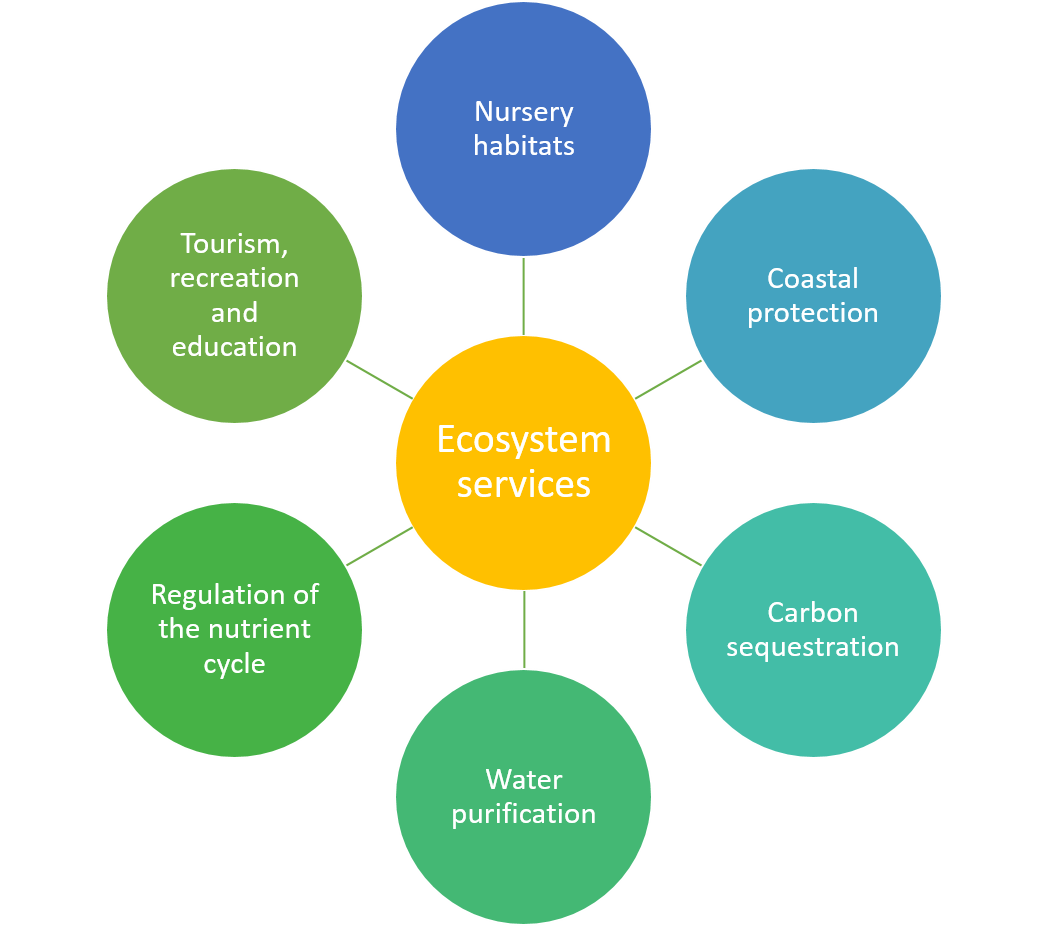Table of Contents
Similar to the grass in the field or on your lawn, seagrasses grow to form homogeneous looking patches of greenery. Everything looks consistent and similar – you can barely tell an individual plant from another (Figure 1).
 |
| Figure 1: A typical seagrass patch. (Photo taken by Cheok Zi Yu) |
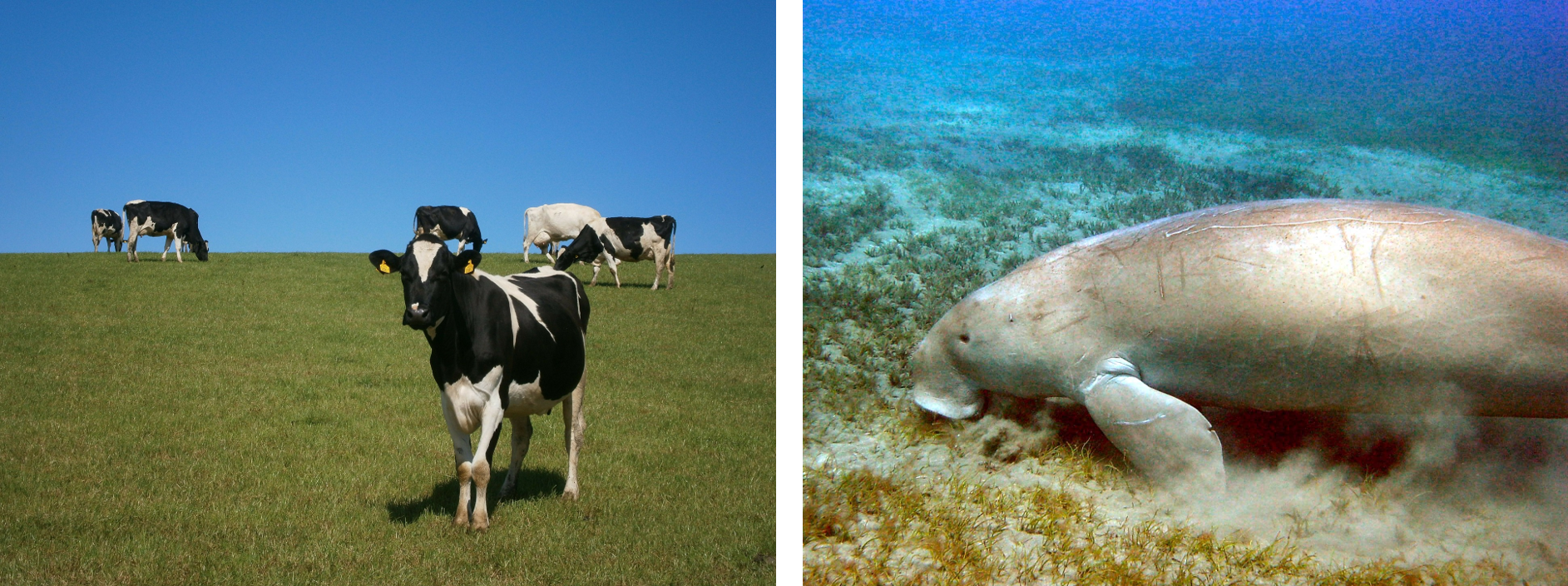 |
| Figure 2: From left, the domesticated cow and its marine counterpart, the sea cow, or Dugong both grazing on their favourite foods. Images under Creative Commons license |
A seagrass is:
- An angiosperm
- Has acquired tolerance to submergence and salinity
- Hydrophilous
- Clonal
- Able to compete effectively in marine environments
This page strives to educate about seagrass habitats and their conservation, with a focus on the island-state of Singapore and an important but under-studied seagrass species, Thalassia hemprichii. In this section, we emphasize the importance of seagrass habitats and the anthropogenic reasons behind their decline, with a focus on seagrass meadows in Singapore.
Thalassia hemprichii
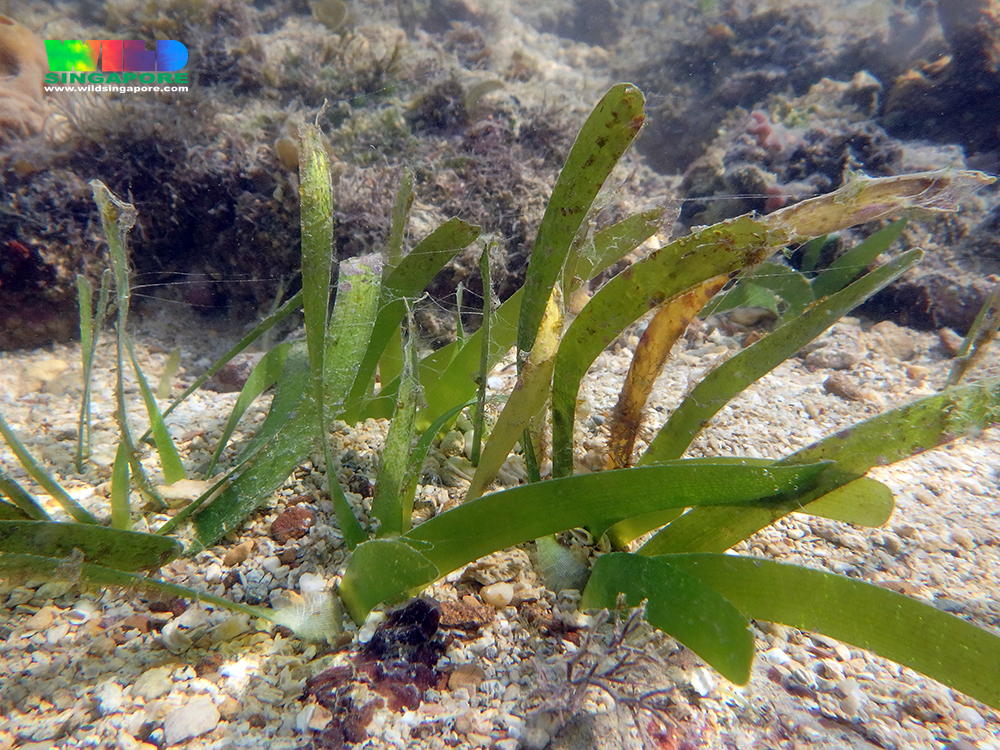 |
| Figure 3: Thalassia hemprichii when submerged. Image courtesy of Ria Tan (Wildsingapore) |
- Long lived, retaining resources for a longer period of time compared to pioneer species[5]
- Has large shoots that extend into the water column, forming a canopy (Figure 3)[6]
Habitats to Ocean Life
The following video gives you a glimpse into the variety of wildlife found in a temperate seagrass habitat, imagine how much richer a tropical seagrass meadow could be!| Video courtesy of Aquaworks Underwater Films |
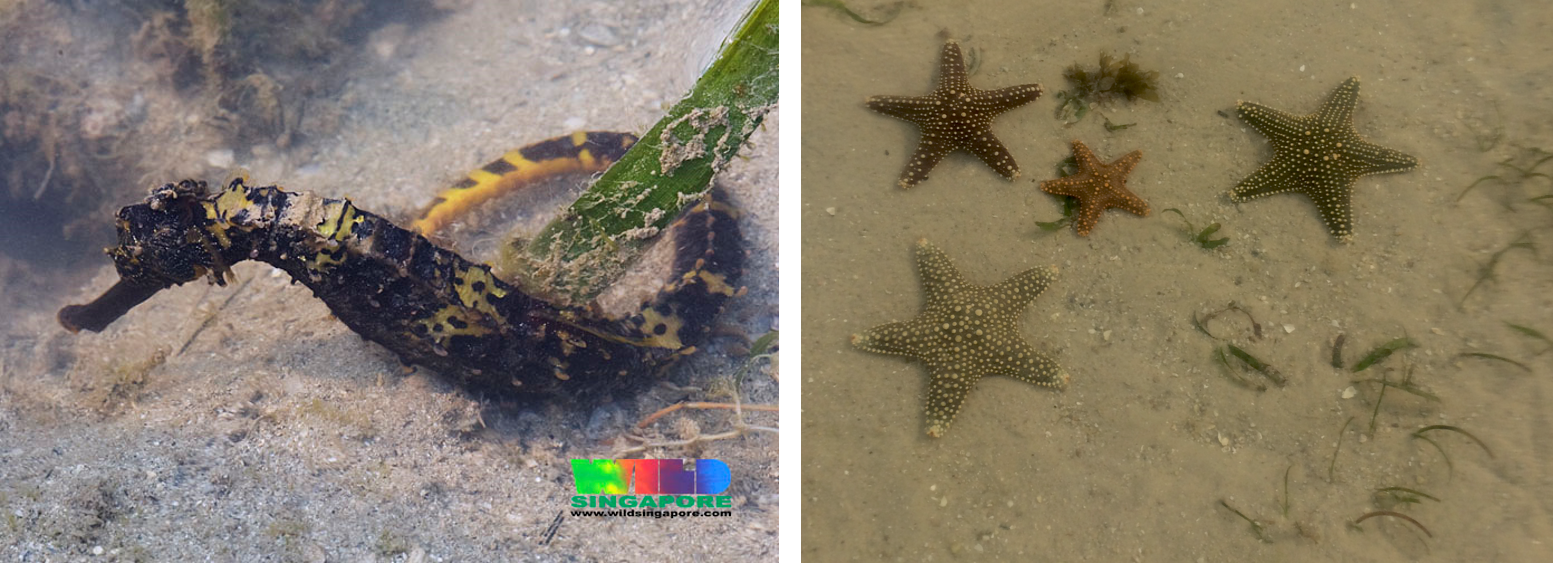 |
| Figure 4: From left, Hippocampus comes, Tiger Tail Seahorse (image courtesy of Ria Tan (Wildsingapore)) and Pentaceraster mammillatus, Pentaceraster Sea Star (taken by Cheok Zi Yu) found on seagrass patches in Singapore |
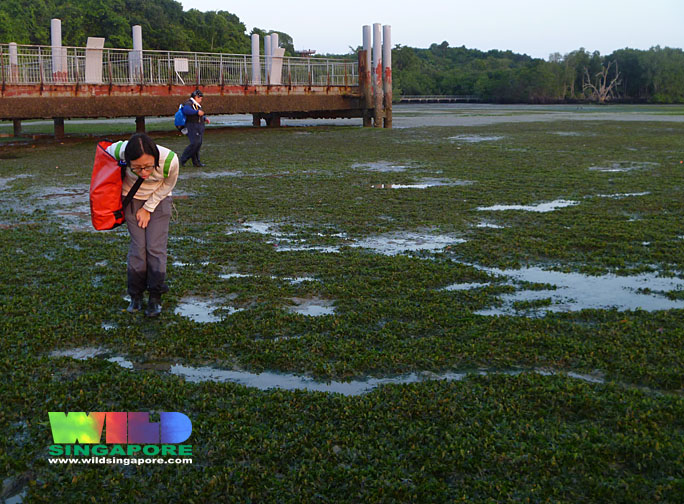 |
| Figure 5: A dugong feeding trail |
Ecosystem Services
Seagrass medows provide numerous ecosystem services, summarised in Figure 6 below, cumulating to a value of USD $19,004 per hectare per year! This value is almost twice that of other coastal ecosystems, where each has values of between USD $6,000-10,000 [1] .
|
Seagrass meadows are home to commercially important species such as Giant Tiger Prawns (Peneaus monodon and P. semisulcatus), Whitings (Merlangius merlangus), Snappers (Lutjanus synagris, L. apodus etc.) and more. Decline of seagrass meadows has been predicted to cause significant economic losses in the fishery industy[12] . Seagrass meadow's high productivity and canopy cover are important in counteracting two key aspects of global warming: unprecedented levels of carbon dioxide in the air and sea level rise. Seagrasses consume carbon dioxide in the water as they grow, storing carbon and acting as a carbon sink[14] . This is particularly true of the persistent climax seagrass species such as T. hemprichii, which are long lived[15] . The leaves of seagrasses slow down wave velocity during storms and their roots stablise sediments, protecting coasts from erosion, which is important as the sea level continues to rise[16] . T. hemprichii meadows are also thought to experience enhanced deposition relative to meadows where other species dominate[7] , an added benefit of having this species around! |
Human Impacts on Seagrass Meadows
Throughout the world, seagrass habitats are declining at devastating rates[3] . The reduction in percentage of seagrass cover in the world has already decreased by 30% and habitats continue to decline at a rate of 7% per year. If this estimated rate continue unabated, seagrass habitats will disappear within a few decades.Large scale coastal modification activities such as land reclamation bury whole seagrass meadows[17] and increases sediment content in local waters[18] , blocking sunlight reaching the surface of seagrass leaves. Uncontrolled nutrient input from discharges into rivers also cause eutrophication in coastal waters, further lowering light availability[19] . Other mechanisms leading to seagrass loss include mechanical damage by boats [2] and their susceptibility to rising sea levels.
Seagrass Habitats in Singapore
Seagrass meadows in Singapore are usually multispecific, comprising of multiple species, due to the richer seagrass diversity here in the Indo-Pacific region[7] . Singapore's Northern shores have greater freshwater influence compared to the exposed Southern shores due to their proximity to the Johor River in the North. Hence, the meadows in Singapore support high biodiversity due to different combinations of abiotic and biotic factors that make up each individual patch[20] .However, seagrass habitats in Singapore have undergone drastic changes since the start of her development. Land reclamation has radically transformed the country's coasts (Chou 1998); The island of Singapore has grown by 22.9% since 1819[21] . An estimate of past seagrass extent using herbarium records by Yaakub et al. (2014)[22] found that there used to be numerous seagrass patches on the eastern coast of Singapore (Figure 7). Today, that intertidal zone is now land, and there are all but 3 patches left in the area. But there is hope yet! These 3 patches are considered newly formed since land reclamation, and without any purposeful restoration on our part! And one of them, near the Tanah Merry Ferry Terminal, contains Thalassia hemprichii!
 |
| Figure 7: Seagrass meadows in Singapore in the 1950s and 2000s. Note the island's growth in size and a number of newly emerged seagrass patches on the East coast. Edited with permission from Yaakub et al., 2014 |
 |
| Figure 8: This is a re-emerged (and newly discovered) patch located on the southeastern coast of Singapore. It had yet to be recorded when Yaakub et al. (2014) was published |
Biology
This section covers the methods of propagation of T. hemprichii (clonal growth and sexual reproduction) before highlighting its dispersal strategies. At the community level, succession in a meadow and T. hemprichii’s global distribution relative to its sister species is examined.
Clonal Growth (Asexual reproduction)
Clonal growth is the growth of the plant from the same parent cell, meaning that new individuals or ramets are genetically identical to the parent cell. This growth mode of of T. hemprichii cannot occur without its apical meristems (see description). If the meristems are damaged, there are no known specialised responses in the plant. Only the sister species, T. testudinum has been observed to undergo 'twinning', the emergence of two foliar (leaf) tissues from a vertical shoot. Interestingly, as T. hemprichii undergoes asexual growth, the rhizome apex are known to be able to adjust their depth in the sediment in response to erosion or sedimentation[23] . When physical damage of seagrass occurs, it can lead to the formation of fragments that act as potential dispersal vectors (see dispersal).Sexual Reproduction
Thalassia hemprichii and all other seagrass species (except for Enhalus acoroides) are hydrophilous, i.e pollination is carried out using water as the dispersal medium. This is a unique biological characteristic of all seagrasses, which is better discussed from the evolutionary point of view[24] .Thalassia hemprichii seeds have to germinate soon after fertilisation, due to a lack of dormancy period (see dispersal). This precludes the formation of a seed bank, which is the presence of seeds in the soil that can remain dormant but viable over long periods. Research on T. hemprichii seeds found that almost all of them died within six days after burial. The high mortality is thought to be due to high oxygen respiratory requirements of the seeds[25] .
Dispersal
At high densities, population growth is limited due to competition for resources[26] . Water is an abiotic media used by many plants for dispersal[27] .Sexual propagules (fruits and seeds of T. hemprichii) stay buoyant in the water for a few days. In contrast, naturally released T. hemprichii seeds float for a median value of 0.3h - approximately 20 minutes! The floating time is important as positively buoyant propagules are freely dispersed by ocean currents. Once the propagule's buoyancy becomes negative, the features on the bottom of the seafloor becomes an additional obstruction factor[28] . Therefore, the distances travelled by T. hemprichii fruits are longer than that of its seeds:
| Estimated distance travelled |
T. hemprichii[29] |
T. testudinum[30] |
| Seed |
less than 5km |
0.06-3km |
| Fruit |
23km |
less than 1-15km |
Fragments have long been speculated to be an asexual method of dispersal for seagrass. Recently, there has been a number of publications on T. hemprichii fragments as potential dispersal vectors. Wu et al. (2016)[31] , found that T. hemprichii fragments with an apical meristem have a long viability period of up to 3 months, and can potentially act as dispersal vectors. While observed colonization of new habitats by fragments of this species has yet to be reported, Rollon (2001)[32] has documented the emergence of a young T. hemprichii meadow on an isolated Pacific island, a distance floating seeds are unlikely to travel. Combined with local discoveries of re-emerged seagrass meadows containing T. hemprichii, such as the patch in Figure 8, this hints at the possibility of the species being able to disperse via vegetative fragments.
Succession in Seagrass Meadows
Within a meadow, small, round-leaved species dominated closest to the shore. Towards the ocean, narrow leaved species follow before they are replaced by T. hemprichii and other large-leaved species.This zonation is the result of the community succession process - initially, the pioneer species Halophila ovalis rapidly colonises an appropriate patch of barren land, either via seed banks or fragment settlement. H. ovalis will then alter the soil composition, facilitating its own replacement as the dominant species by narrow-leafed species (Halophila uninervis), and finally by climax species such as T. hemprichii[7] .
Distribution
Thalassia hemprichii is mainly found along the coasts in the Indo-Pacific region, while T. testudinum is native to the Carribean sea, extending to the Bermudas.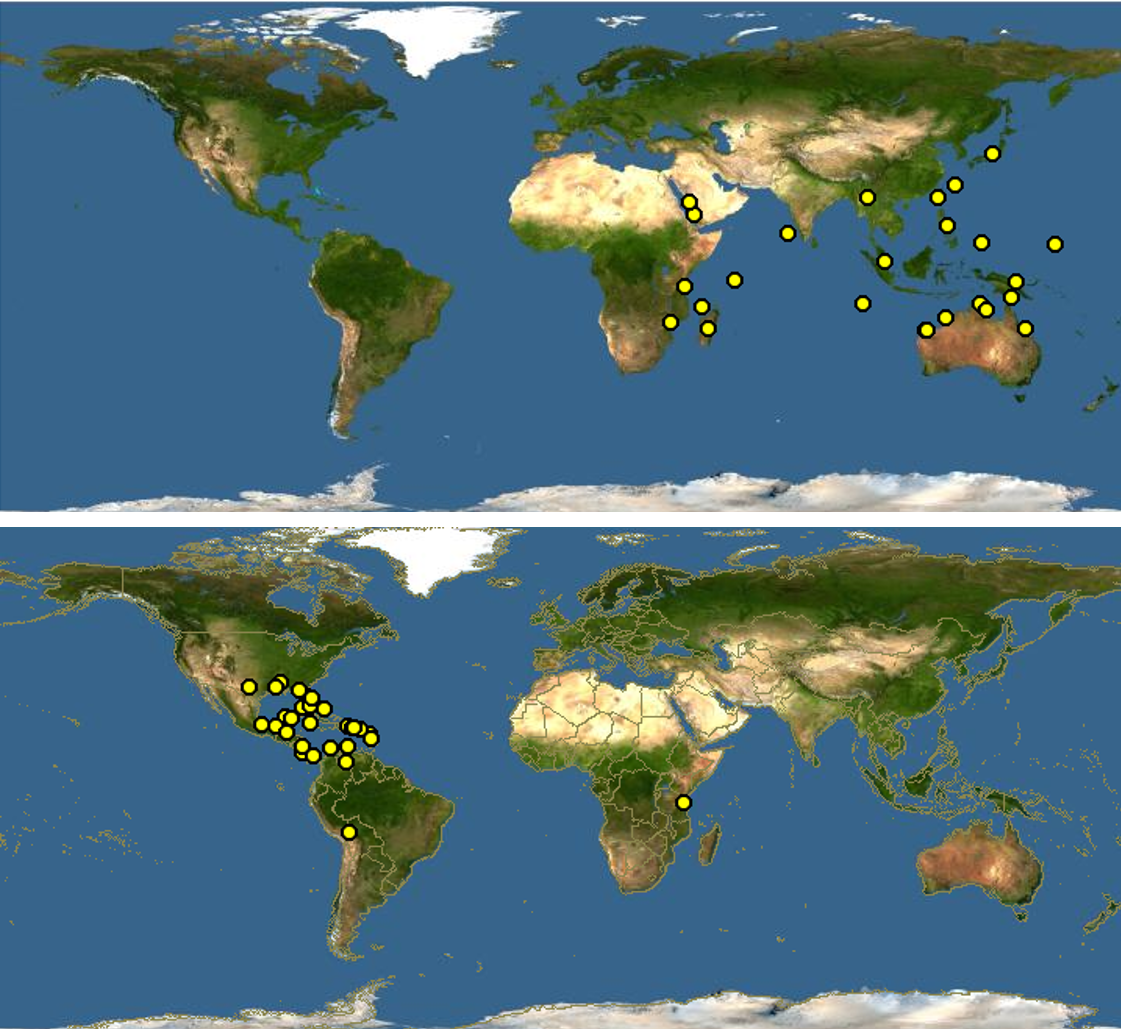 |
| Figure 9: From top, a) distribution of Thalassia hemprichii; b) distribution ofThalassia testudinum. From Discover Life[33][34] . Note that the lone demarcation of T. testudiunum in the east coast of Africa is due to a preserved specimen and is not indicative of the distribution of the species. |
This sections provides a detailed description of T. hemprichii and its diagnosis. We provide insight into its formal name, type specimen and finally, its unique evolution.
Description
Detailed descriptions of seagrass morphology and growth habit for the Thalassia genus were only published in the 20th century. Prominent ones include papers by den Hartog (1957[35] & 1970[36] ), Tomsonlin (1974[37] ) and Tomsonlin and Vargo (1966[23] ). Tomlinson (1974) admitted that his conclusions were merely based on "superficial dissection", and called for more studies on seagrass morphology. However, the advent of DNA sequencing and other molecular methods after his publication likely resulted a further decrease in emphasis on morphology descriptions in taxonomical studies.The habit descriptions below were described for the sister species of T. hemprichii - T. testudinum. Morphologically, both species are essentially similar (see diagnosis and [[Thalassia hemprichii#Evo|evolution).
 |
| Figure 10: Key morphological characters of T. hemprichii. The scars on the rhizome and thick sheath are diagnostic traits that differentiate this species from other seagrass species in the region. Photographs taken by Cheok Zi Yu |
Thalassia hemprichii is known to be highly organised and meristem-dependent in its growth due to the following reasons[23] :
- The number of scale leaves between each pair of vertical shoots is always odd, ranging from 9 to 19. This creates an interesting phenomenon where two successive vertical shoots are always on opposite sides of the rhizome! (Figure 10)
- Meristems on horizontal rhizomes can only give rise to vertical shoots, and vertical shoots can only give rise to a horizontal rhizome - hence the meristems are considered leaf opposed.
- The apical meristem is considered precocious, and cells that eventually become the roots or vertical shoot are specified early in development.
- All organs (roots, shoot, foliage leaves) are initiated within terminal meristems, without them fragments cannot grow or propagate.
- This is in stark contrast to other seagrass species, which have more flexible meristem formation and proliferation patterns. This has spurred questions regarding the response of Thalassia dominated meadows after a disturbance[7] .
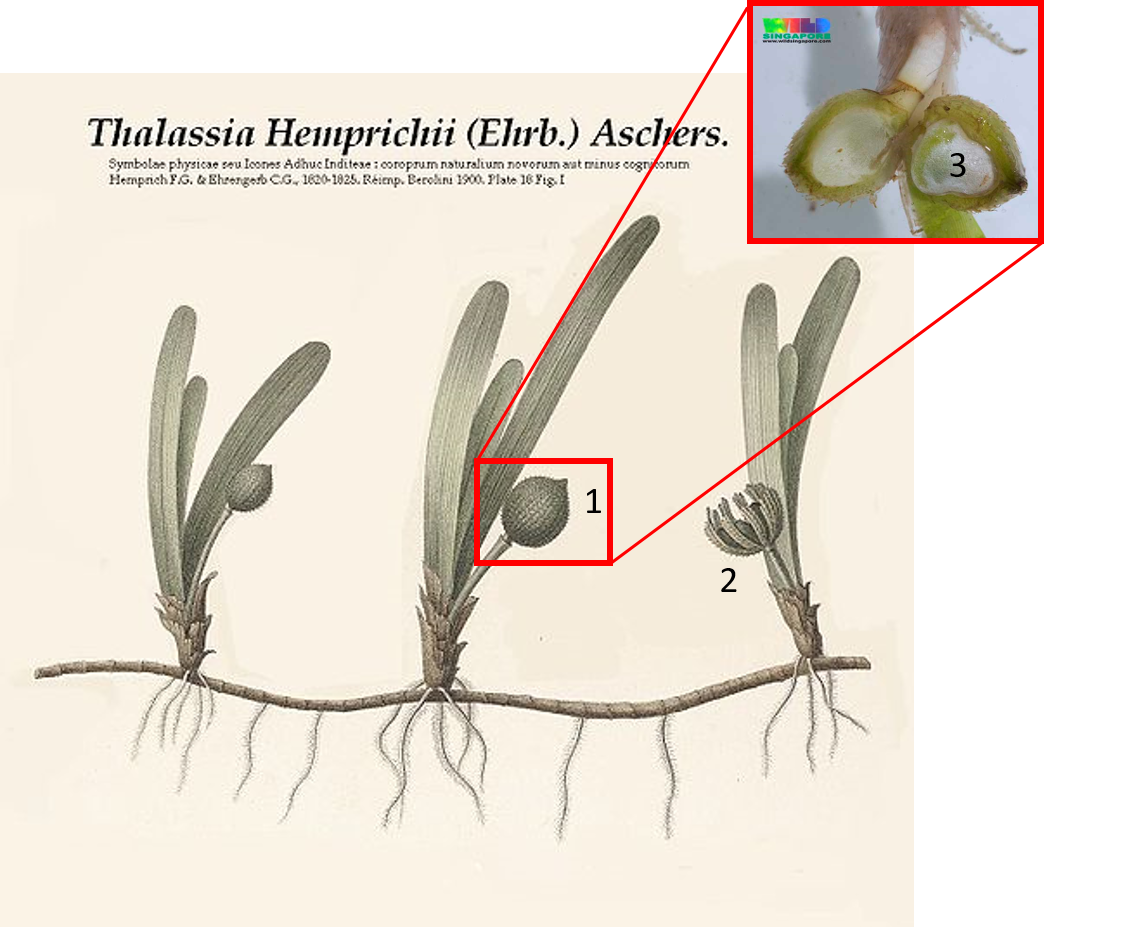 |
| Figure 11: Reproductive structures of T. hemprichii. 1) Fruit; 2) Flower; 3) Seed. Drawing is under creative commons license Wikipedia page and image of the seed is courtesy of Ria Tan (Wildsingapore) |
Diagnosis
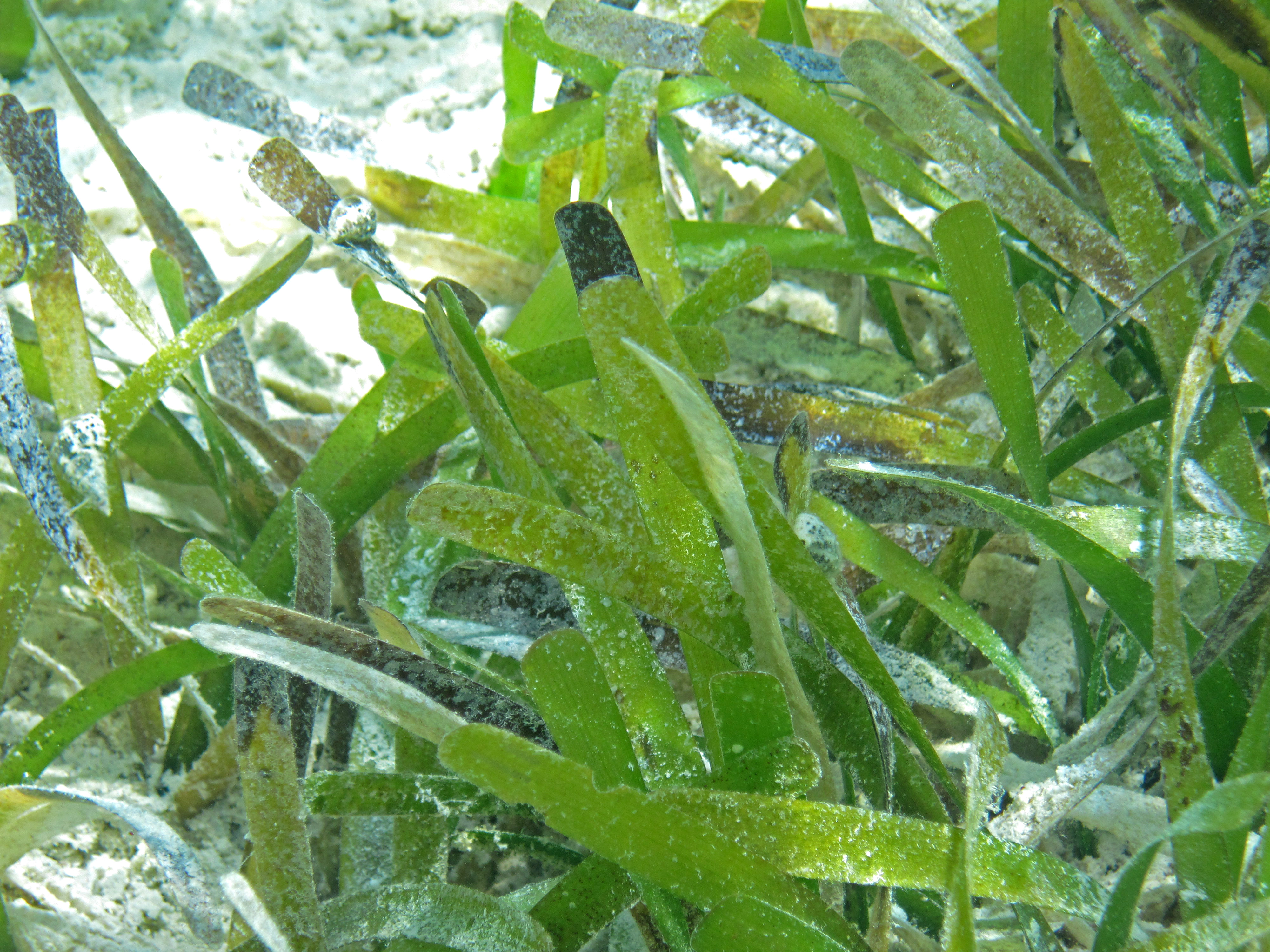 |
| Figure 12: Thalassia testudinum, which looks very similar to Thalassia hemprichii |
| Flower structure (sex) |
T. hemprichii |
T. testudinum |
| Number of styles (female) |
6 |
7-8 |
| Stigmatic branches (female) |
Shorter then its sister species |
Longer than its sister species |
| Number of stamens (male) |
3-12 |
9 |
Classification and Nomenclature
| Kingdom |
Plantae |
||||||||
| Phylum |
Tracheophyta |
||||||||
| Class |
Liliopsida |
||||||||
| Sub class |
Alismatidae |
||||||||
| Order |
Hydrocharitales |
||||||||
| Family |
Hydrocharitaceae |
||||||||
| Genus |
Thalassia |
||||||||
| Species |
Thalassia hemprichii |
Common names: Sickle Seagrass, Dugong grass, Turtle grass (shares this name with its twin species, T. testudinum)
Species name: Thalassia hemprichii (Ehrenb. ex Solms) Asch. 1871
| Original taxonomical document by Ascherson[38]Read online |
Synonym: Schizotheca hemprichii Ehrenb. ex Solms 1834
| A snapshot (incomplete) of the original description of the species (in German)[39]Read online |
Type Information
The original holotype collected by Ehrenberg cannot be located and appears to have been lost. Ferrer-Gallego and Boisset (2015) subsequently selected what they called a “lectotype” for T. hemprichii after evaluating all the herbarium sheets that have been referenced for the species. The “lectotype” is currently designated as: Eritrea, Massaua, Mare rubrum, Ehrenberg s.n. (BM barcode BM000922237!; isolectotypes: K barcode K000911822!, L barcodes L1203715! & L1203710!, P barcodes P02074514! & P02074520!)[40] .Before explaining why this new type was designated as a “lectotype” as opposed to a “neotype”, let us examine the definitions of each term for animals (under the International Commission on Zoological Nomenclature, ICZN) and plants (International Association for Plant Taxonomy, IAPT).
| ICZN |
IAPT[41] |
|
| Neotype |
To replace a missing holotype[42] |
Serves as a holotype “as long as all of the material on which the name of the taxon was based is missing” |
| Lectotype |
Becomes the holotype, chosen from a set of syntypes[43] |
A specimen/illustration of the original material if no holotype was indicated at the point of publication, or if holotype is missing – it takes precedence over the neotype |
Evolutionary origin
The phylogenetic study by Les et al. (1997) was carried out using a chloroplast gene rbcL. From Figure 13, 2 possibilities on the evolution of seagrasses can be deduced: there were either 2 (set of red arrows in Figure 13) or 3 (set of orange arrows) independent evolutions that gave rise to seagrasses. The paper eventually concluded that it was likely to be three independent invasions. If there were only 2 independent evolutions, a reversal back to the freshwater adapted state for the Zannichelliaceae/Potamogetonaceae clade will be required, a process that they thought was highly unlikely.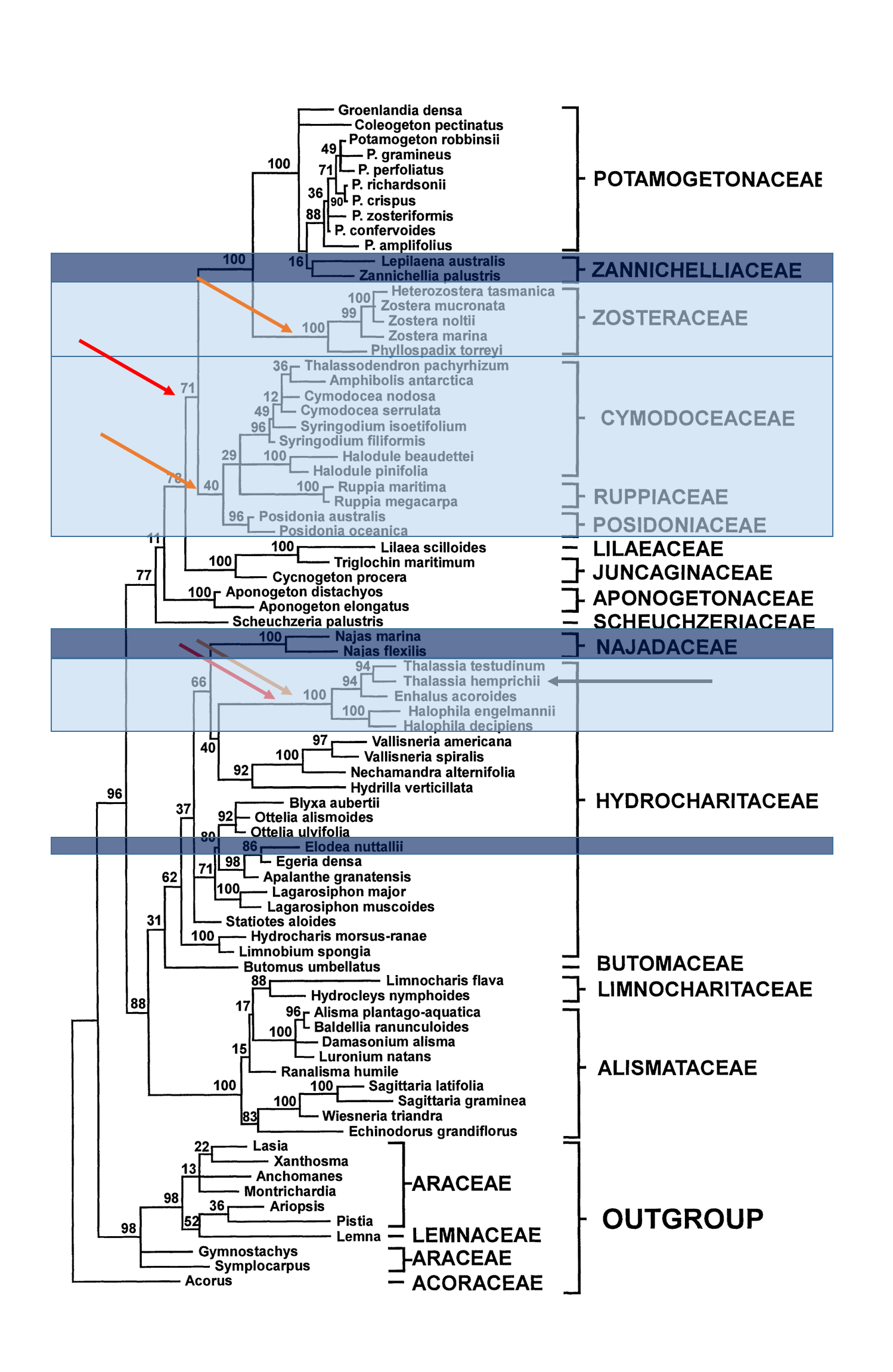 |
| Figure 13: Strict consensus phylogenetic tree depicting evolutionary relationships between aquatic angiosperms, species within light blue boxes are "seagrasses" with T. hemprichii marked with a black arrow, and non-seagrass hydrophilic species are boxed in dark blue. Orange and red arrows mark two hypothetical origins of "seagrasses". Used with permission from Les et al. (1997) |
Hence, seagrasses are an ecological group as they are not monophyletic. Instead, they are grouped together for the convenience of their distinctive ecological niche [46] .
Figure 13 also shows that salinity tolerance seagrasses did not evolve in a step-wise manner, i.e. are not evolved from a "'mangrove-like' saltwater plant". The bootstrap support for the seagrass clades within Hydrocharitaceae and Zosteraceae are 100%. For the Cymodoceaceae family the value is lower, at 40%. However, all are nested within freshwater species. Hence, seagrasses are likely to have descended from a freshwater angiosperm ancestor (Tomlinson 1974).
Specifically for the Thalassia genus , it is a clear monophyletic group within the Hydrocharitaceae family, with 94% bootstrap support. Within the genus, there are only very small-scale differences between the morphologies of the two sister species, but clear divergence was found when their DNA sequences were compared [47] . The species are hence thought to have been the result of allopatric speciation, when continental drift more than 24 million years ago split the populations of the Thalassia ancestor into two[7] , giving rise to the two sister species.
Glossary of terms
| Angiosperm |
a flowering plant |
| Asexual Reproduction |
Incliudes seed production without fertilisation and 'selfing' (clonal growth) |
| Carbon sink |
a natural environment that stores carbon for a long period of time |
| Cryptoviviparious |
the embryo within the seed grows to become a seedling while the seed is still attached to the parent plant |
| Diagnosis |
Unique descriptions on a species enabling you differentiate from other species |
| Dioecious |
male and female reproductive organs are found on separate individuals |
| Epiphytes |
sessile organisms that grow on plant. Compare to the terrestrial definition Wikipedia |
| Habit |
the general shape or appearance of the plant |
| Holotype |
a single type specimen upon which the description and name of a species is based on |
| Hydrophilous |
a pollination system where pollen grains are transported on or below the surface of water (Les 1988), thought to be a requirement for invasion of marine habitats |
| Infauna |
a group of animals which live within the sediments of aquatic habitats |
| Lectotype |
a subsequent type chosen to serve as the holotype of a species |
| Monocots |
a group of flowering plants with seeds that contain one embryonic leaf |
| Monophyletic |
a group of organisms (clade) that consists of an ancestor and all of its descendants |
| Nomenclature |
The naming of a species |
| (Primary) productivity |
rate at which energy gets converted into organic carbon via photosynthesis |
| Taxonomy |
the traditional definition, which encompasses species descriptions (alpha) and assigning them into higher classifications (beta) |
Further Information
Differentiating seagrass species in Singapore: Ribbon-like seagrasses
Monitoring seagrasses along Singapore's shores: Team Seagrass
Type specimen: Type specimen of //T. hemprichii//
Informative pages on the Sickle Seagrass: Algaebase; IUCN; ITIS
References
- ^ Chase, M. W. (2004). Monocot relationships: an overview. American Journal of Botany, 91(10), 1645-1655.
- ^ Duarte, C. M., Dennison, W. C., Orth, R. J., & Carruthers, T. J. (2008). The charisma of coastal ecosystems:addressing the imbalance. Estuaries and coasts, 31(2), 233-238.
- ^ Waycott, M., Duarte, C. M., Carruthers, T. J., Orth, R. J., Dennison, W. C., Olyarnik, S., ... & Kendrick, G. A. (2009). Accelerating loss of seagrasses across the globe threatens coastal ecosystems. Proceedings of the National Academy of Sciences, 106(30), 12377-12381.
- ^ Davison, G.W. H. and P. K. L. Ng and Ho Hua Chew, 2008. The Singapore Red Data Book: Threatened plants and animals of Singapore. Nature Society (Singapore). 285 pp.
- ^ Vermaat, J. E., Agawin, N. S. R., Duarte, C. M., Fortes, M. D., Marba, N., & Uri, J. S. (1995). Meadow maintenance, growth and productivity of a mixed Philippine seagrass bed. Marine Ecology Progress Series, 124, 215-225.
- ^ Hughes, A. R., Williams, S. L., Duarte, C. M., Heck, K. L., & Waycott, M. (2009). Associations of concern: declining seagrasses and threatened dependent species. Frontiers in Ecology and the Environment, 7(5), 242-246.
- ^ van Tussenbroek, B. I., Vonk, J. A., Stapel, J., Erftemeijer, P. L., Middelburg, J. J., & Zieman, J. C. (2007). The biology of Thalassia: paradigms and recent advances in research. In SEAGRASSES: BIOLOGY, ECOLOGYAND CONSERVATION (pp. 409-439). Springer Netherlands.
- ^ Thayer, G. W., Wolfe, D. A., & Williams, R. B. (1975). The Impact of Man on Seagrass Systems: Seagrasses must be considered in terms of their interaction with the other sources of primary production that support the estuarine trophic structure before their significance can be fully appreciated. American Scientist, 63(3), 288-296.
- ^ Barbier, E. B., Hacker, S. D., Kennedy, C., Koch, E. W., Stier, A. C., & Silliman, B. R. (2011). The value of estuarine and coastal ecosystem services. Ecological monographs, 81(2), 169-193.
- ^ Amesbury, S. S., & Francis, J. H. (1988). The role of seagrass communities in the biology of coral reef fishes:experiments with artificial seagrass beds. Sea Grant Quarterly, 10(1), 1-6.
- ^ Williams, S. L., & Heck Jr, K. L. (2001). Seagrass community ecology. Marine community ecology, 317-337.
- ^ McArthur, L. C., & Boland, J. W. (2006). The economic contribution of seagrass to secondary production in South Australia. Ecological modelling, 196(1), 163-172.
- ^ IOSEA Marine Turtle MoU. (n.d.). Seagrasses. Retrieved Nov 20, 2016, from Indian Ocean - SEA Marine Turtle Memorandum of Understanding: http://www.ioseaturtles.org/
- ^
Duarte, C. M., Middelburg, J. J., & Caraco, N. (2005). Major role of marine vegetation on the oceanic carbon cycle. Biogeosciences, 2(1), 1-8.
monospecific Thalassia hemprichii meadows in the Kalayaan Island Group. Aquatic Botany, 71(3), 239-246.
